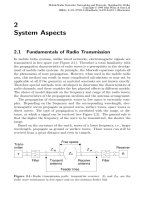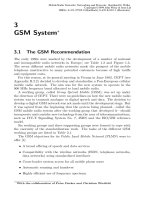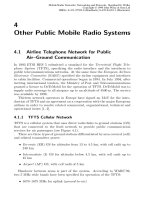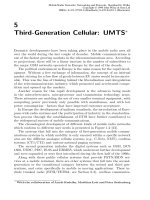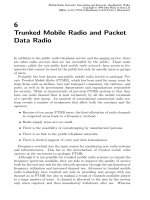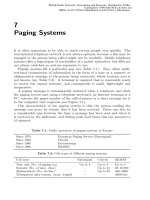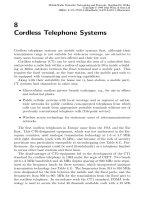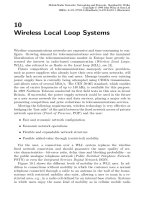Tài liệu Điện thoại di động băng thông rộng không dây P8 docx
Bạn đang xem bản rút gọn của tài liệu. Xem và tải ngay bản đầy đủ của tài liệu tại đây (2.77 MB, 20 trang )
5
Initiatives in 4Gmobile Design
5.1 Introduction – Who Needs 4G? What is 4G?
5.1.1 Social Background and Future Trends
There has been an evolutionary change in mobile communication systems every decade.
The increase in the number of subscribers and transmission data rates leads to a shift to
higher frequency bands where wider bandwidth is available. There are two directions for
future trends in mobile communications. One is Direction A, which aims to increase
transmission data rates where the same mobility as IMT-2000 from indoor to high speed
vehicles is maintained. The other is Direction B, which aims to expand mobility from
indoor to outdoor where the transmission data rates in the wireless access systems are
maintained. Direction B will be suitable for spot area services in order to satisfy the demand
for higher data rates, while Direction A will accommodate continuous area services. We
focus on Direction A here.
The number of subscribers using PDC and PHS in Japan was 62.2 million in October 2000
and has increased by 10 million for 5 successive years. One in 2.6 mobile phone users
connected to the Internet in October 2000. This pattern of use has increased significantly,
and Internet use is expected to comprise 90 percent of all mobile communication traffic in
2005. The US and Europe are expected to follow a similar trend.
Figure 5.1 shows a traffic forecast for Region 3 [97]. From 1999 through 2010, subscribers
to voice-oriented services are expected to grow by 1.5 times, and the ratio between voice and
multimedia traffic will be nearly 1:2 for total up- and downlinks. Assuming that multimedia
traffic grows by 40 percent a year after 2010, it will be 23 times that of 1999, and the ratio
between voice and multimedia traffic will be about 1:10.
Therefore, to accommodate the considerable multimedia traffic after 2010, we must
conduct R&D on key technologies to achieve not only high speed mobility but also high
transmission data rates.
5.1.2 Trends in ITU-R
At the 18th TG-8/1 in November 1999, the standardisation activities on IMT-2000 were
finished and the new working party (WP8F) was established to co-ordinate on systems
beyond IMT-2000 as well as to enhance IMT-2000 itself. At the first WP8F meeting in
Broadband Wireless Mobile: 3G and Beyond. Edited by Willie W. Lu
Copyright
2002 John Wiley & Sons, Ltd.
ISBN: 0-471-48661-2
March 2000, 6 working groups were set up (see Figure 5.2) and their terms of reference are as
follows [22].
WG-Vision:
† Provision of the roadmap to the future in relation to the time perspectives for IMT-2000
and systems beyond IMT-2000.
† Co-ordinate and complement the near term aspects of the Radio Technology Working
Group and co-ordinate with the other groups in WP 8F.
† Conceptualisation of the longer term future (5 to 10 years) and migrate it through a middle
defining stage (3 to 7 years) to ultimately deliver a near term work product of specifica-
tions as defined in related working groups.
† Maintenance and update of other IMT-2000 recommendations (such as concepts, princi-
ples, framework requirements and the like).
WG-Circulation:
† Address to issues that may facilitate the ability of IMT-2000 to achieve global deployment
including access, circulation, and common emission requirements.
WG-Developing IMT:
† Consideration of issues relevant to the needs of the developing countries.
† Assurance of the work on IMT-2000 adequately reflects these needs. Conduct of studies in
response to Question ITU-R 77/8 and strengthening the liaison with ITU-D as necessary.
† Maintenance and update of relevant IMT-2000 recommendations as appropriate may
occur within this working group.
Broadband Wireless Mobile: 3G and Beyond272
Figure 5.1 Traffic Forecast for Region 3 in 2010 and after.
WG-Radio technology:
† Maintenance and update of IMT-2000 RSPC terrestrial component in conjunction with
external organisations.
† Maintenance and update of IMT-2000 RSPC satellite component in conjunction with WP
8D.
† Maintenance and update of other IMT-2000 recommendations as appropriate may occur
within this working group; address aspects of adaptive antennas for IMT-2000 including
technical characteristics, advantages, performance implications and applications.
† Consideration of other aspects of technology related to IMT-2000; reception of the work
products of the ‘mid-term’ perspective of the WG-Vision and in the ‘near-future’ updates
existing specification recommendations or develops new recommendations as appropriate
to support implementations of these concepts.
† Co-ordination with external organisations in this task will be required.
WG-Spectrum:
† Spectrum matters related to IMT-2000 and systems beyond IMT-2000; considering IMT-
2000 spectrum implementation issues and any necessary sharing, compatibility and inter-
ference criteria between IMT-2000 and other radio services
Initiatives in 4Gmobile Design 273
Figure 5.2 Working Group relationship diagram.
† Maintenance and update of existing IMT-2000 spectrum related recommendations and
reports, as appropriate
† Identifying areas where joint work and/or liaison is needed on spectrum matters with other
relevant groups, as appropriate.
WG-Satellite Co-ordination:
† Act as internal WP 8F co-ordinating function and focal point for satellite aspects
† Function as the WP 8F point of interface for draft liaison statements to WP 8D on satellite
issues
† Maintenance and update of ITU-R recommendations related to IMT-2000 and systems
beyond IMT-2000 and will work closely with WP 8D
† Determine which WP 8F documents are relevant to WP 8D.
According to the WG-Vision, a target of service beyond IMT-2000 is illustrated with that
of each mobile communication and wireless access service in Figure 5.3, and four scenarios
for the systems beyond IMT-2000 are proposed, as shown in Figure 5.4 [23].
Scenario 1: All-round-type (Figure 5.4(a))
Covers the whole range of the deployment area and the transmission rate.
Broadband Wireless Mobile: 3G and Beyond274
Figure 5.3 Target of Service beyond IMT-2000.
Scenario 2: Complement-type (Figure 5.4(b))
Located in the position not covered by the other mobile communication and wireless
access systems, both in terms of the deployment area and the transmission rate.
Scenario 3: Area-complement-type (Figure 5.4(c))
They cover the whole range of the transmission rate and are located in the position not
Initiatives in 4Gmobile Design 275
Figure 5.4 Scenarios of systems beyond IMT-2000: (a) all-round type, (b) complement type, (c) area
complement type, and (d) rate complement type.
covered by the other mobile communication and wireless access systems in terms of the
deployment area.
Scenario 4: Rate-complement-type (Figure 5.4(d))
They cover the whole range of the deployment area and are located in the position not
covered by the other mobile communication and wireless access systems in terms of the
transmission rate.
Broadband Wireless Mobile: 3G and Beyond276
Figure 5.4 (continued)
5.1.3 Wireless Access Systems Related to 4G Mobile
The following system requirements should be met in 4G mobile:
† high data-rate transmission
† high mobility
† wide coverage area and seamless roaming among different systems
† higher capacity and lower bit cost
† wireless QoS resource control
Because it is especially hard to realise the system having both high data rates and high
mobility, four scenarios are discussed in WG-Vision (see section 5.1.2). There is an idea to
include new communication systems such as ITS (Intelligent Transport Systems) and HAPS
(High Altitude stratospheric Platform Station) systems at a research level (see Figure 5.5).
There is also another approach organised in a layered structure similar to hierarchical cell
structures in cellular mobile systems (see Figure 5.6), where vertical handover between
systems as well as horizontal handover within a system is necessary [83].
5.1.4 Key Technologies
It is very important to develop key technologies realising high data rates transmission under
high mobility. Some of them are illustrated in Figure 5.7 [97], and recent research activities
are introduced in detail after 5.2.
5.2 Microwave Propagation
In recent years there has been a tremendous upsurge in demand for terrestrial mobile wireless
Initiatives in 4Gmobile Design 277
Figure 5.5 Mobile communications systems.
communications, yet the availability of spectrum for mobile communications has become
increasingly scarce as the information-oriented society has continued to evolve. In pursuit of
new spectrum for mobile communications, many are casting their eyes to the hopeful
prospects of the microwave band [105]. In order to adopt the microwave spectrum for use
by mobile communications, it is essential to gain a clear understanding of the propagation
Broadband Wireless Mobile: 3G and Beyond278
Figure 5.6 Layered structure of seamless future network [83].
Figure 5.7 Key technologies in wireless access networks.
characteristics of the frequency band and bandwidth of the spectrum to be used. While the
sub-microwave band (,2 GHz) has already been extensively developed [4,10], the propaga-
tion characteristics of microwave (.3 GHz) transmission at 10 Mb/s or more continue to be
studied and still have numerous issues to be addressed. Microwave transmission exhibits
greater path losses than conventional UHF-band communications, and it is assumed this can
be attributed to frequency selective fading associated with broadband transmission and
increased shadowing caused by shrinking Fresnal zones.
In order to identify potential service areas, it is essential to clarify attenuation caused by
multiple rays as a function of distance, attenuation caused by obstructions, time variation of
multiple rays, and so on. In addition, there are other issues that must be addressed if we are to
implement high-speed, high-quality microwave transmission including: delay time difference
characteristic of multiple ray propagation paths and the problem of multiple rays separating
and combining. Note too that demand and environments of interest are no longer confined, as
they once predominately were, to cities. As the number of SOHO (small office, home office)
workers and home-based telecommuters continues to grow, the service demand area is being
rapidly pushed out into suburban residential areas, so careful thought must be given to the
impact that this kind of environment has on microwave propagation. The only way to resolve
these issues is to gather the relevant data through well-designed experimental studies, and to
develop accurate models based on the data.
5.2.1 Microwave Mobile Propagation Characteristics in Urban Environments
5.2.1.1 Propagation loss characteristics
LOS propagation losses and breakpoint characteristics
Microcellular systems featuring transmitting base station antennas installed at a height of
4 m show excellent promise for transmitting in the microwave band. The attenuation coeffi-
cient of line-of-sight (LOS) path loss characteristics for these systems can be divided into a
2nd power domain and a 4th power domain, and results for propagation characteristics along
roads is in agreement with existing reports for lower frequency transmissions.
This point of transformation is referred to as the breakpoint. It has been reported that the
point at which the breakpoint appears in urban environments depends on the height of the
receiving antenna [79]. When the receiving antenna height (h
m
) is set to 2.7 m in urban
districts, it is found that the actual measured breakpoint tends to be somewhat shorter than
the theoretical value derived taking the reflected waves off the road surface into considera-
tion. If one assumes for the theoretical calculation that the road surface is uniformly elevated
by a certain degree, then the discrepancy between measured and theoretical values disap-
pears. Indeed, we can interpret the presence of vehicles passing back and forth on the road as
effectively raising the surface of the road. When we move the receiving antenna down to a
height of h
m
¼ 1.6 m, the measured results detect no breakpoint at all. This is attributed to the
fact that passing vehicles frequently interrupt the propagation path, thus causing non-line-of-
sight (NLOS) characteristics to appear. We obtained an average attenuation coefficient of 3.2,
thus revealing a rather different property than has been obtained for propagation along road at
lower frequencies.
Measurements performed in the urban environment were separated into those conducted
during the day and those done at night [77]. During the night there were less the one-tenth the
Initiatives in 4Gmobile Design 279
number of vehicles on the road as during the day and virtually no pedestrians. Using a
quantitative method, we obtained distinctive breakpoint results of 320 m when measurements
were done at night for h
m
¼ 2.7 m and a frequency f ¼ 3.35 GHz. Comparing this measured
value with the theoretical value (first Fresnel zone theory), we obtain an approximate effec-
tive road surface height h of 0.6 m.
For daytime measurements under heavy traffic conditions at f ¼ 3.35 GHz it was confirmed
that h ¼ 1.3 m (with a breakpoint of 170 m), and 1.4 m for the three-frequency average. It is
apparent that when traffic volume is light, the effective road height is reduced and the break-
point becomes more distant. We also obtained the breakpoint based on path loss character-
istics measured during the day and at night for h
m
¼ 1.6 m. At three frequencies, effective
road heights ranging from 0.2 m to 0.7 m were obtained, for an average of 0.5 m. The fact that
h never reached 0, even for sidewalks during periods when there were virtually no people
walking about, can be attributed to the presence of trees, street lights, and cars passing on
cross streets (Figures 5.8 and 5.9).
NLOS path loss characteristics
In this section we consider the NLOS path loss characteristics. Figure 5.10 shows typical
measured path loss results as a function of distance [78], and reveals sharp jumps in losses at
corners where the LOS path changes to a NLOS path. For these measurements, the transmit-
ting base station was set up on a straight street (11 m wide) while the mobile receiver
travelled down the same straight street then turned off onto two side streets, one (35 m
wide) that was 64 m from the base station and the other (44 m wide) 429 m from the base
station.
The path loss characteristics for the NLOS portion can divided into losses that occur right
at the short interval where the straight road turns the corner onto the side road (i.e., corner
losses, L
c
), and the section of road after that where constant attenuation coefficient a is
observed. Based on measurement for this work, we found that the L
c
interval, where the
signal level drops precipitously, is approximately 20 m.
For purposes of calculating the attenuation coefficient a, we used the entire distance
Broadband Wireless Mobile: 3G and Beyond280
Figure 5.8 Propagation loss characteristics (h
m
¼ 2.7 m).
including the LOS portion. At three different frequencies, we obtained the following L
c
and a
values for the 64-m/429-m corners, see Table 5.1.
The L
c
and attenuation coefficient do not reveal any dependence on frequency. It is not
certain what effect the LOS distance has on L
c
, but it is clear that the farther the intersection is
away from the base station, the greater the attenuation coefficient. Compared to the NLOS
Initiatives in 4Gmobile Design 281
Table 5.1 Estimated corner loss (L
c
) and attenuation coefficient (a)
Frequency L
c
a
64-m corner/429-m corner 64-m corner/429-m corner
3.35 GHz: 17 dB/16 dB 4.6/12
8.45 GHz: 22 dB/28 dB 4.9/28
15.75 GHz: 23 dB/22 dB 4.1/15
Figure 5.9 Propagation loss characteristics (h
m
¼ 1.6 m).
Figure 5.10 Propagation loss characteristics (h
b
¼ 4.0m, h
m
¼ 1.6 m, f ¼ 3.35 GHz).
propagation characteristics for the UHF band (L
c
¼ 10–25 dB, a ¼ 4–12), L
c
and a are both
rather large.
Polarisation characteristics
This section will cover the polarisation characteristics for microwave transmissions in an
urban environment using a base station antenna installed at a low height. Measured results
have already been reported for a trial that the base station (BS) antenna height, h
b
, was 4 m,
the frequency was 8.45 GHz, and the receiving mobile station (MS) employed an antenna
mounted on a moving vehicle about 3 m off the ground [121]. Comparing both of the BS and
MS with vertical polarisation antenna, it was found when changing the polarisation of either
of the BS or the MS that the path losses of the LOS path increased by about an average of
15 dB. Under the same conditions, the path losses for the NLOS path increased by about
9 dB. These correspond to the cross polarisation discrimination (XPD), the ratio of received
power when the transmitted signal and received signal have different polarisations.
In contrast to a study that obtained an XPD of 6 dB using a high base station antenna in the
UHF band [108], here we used a lower base station antenna. We obtained a larger XPD and
the results for the LOS path were greater than those for the NLOS path. Using the low base
station antenna, the diversity effect from the polarisation tended to be rather small.
Fading characteristics
In mobile communications, fading often occurs even when the mobile station is not moving.
This is because of the effects of vehicles and other objects present in and around the propaga-
tion path. It has been reported that these variations will differ depending on the volume of
traffic even in LOS terrain [122]. Figure 5.11 shows the path loss distribution results on
Rayleigh probability paper for high and low traffic volumes measured over a 200-m distance
Broadband Wireless Mobile: 3G and Beyond282
Figure 5.11 Cumulative distributions of the path losses for different traffic conditions (h
b
¼ 4m,h
m
¼
1.3 m, f ¼ 8.45 GHz, High traffic: 1500 units/30 min.; low traffic: 600 units/30 min.).
between transmitter and receiver in an urban environment. As the figure makes clear, the path
loss distribution approximates the Rayleigh distribution when the traffic volume is high even
for LOS transmissions. When traffic is low, on the other hand, there are at least two stable
components resulting from the direct wave and the wave reflected off the ground and inco-
herent components. As noted by Durgin et al. [25], these additive signals produce a distribu-
tion in which deeper fading occurs than in Nakagami-Rice distributions.
5.2.1.2 Propagation delay characteristics
Delay profiles
Delay profiles were measured by transmitting a PN-encoded signal and using a channel
sounder [136]. The receiver of the sounder is stabilised by a rubidium standard signal
generator. The AGC dynamic range is 50 dB, and the receiver has a dynamic range of
60 dB with a snapshot. The chip rate is 50 Mbit, and this permits measurements with a
time resolution of 20 ns. Figure 5.12 shows typical measured delay profiles for an urban
environment [136].
For the LOS transmission, the delay characteristics exhibit different behaviours between
before the breakpoint and after the breakpoint. The results of an earlier study showing the
delay spread cumulative distribution for 3.35 GHz frequency are presented in Figure 5.13
[80]. Approximating a straight line, the distribution exhibits a logarithmic normal distribu-
tion. The slope of the distribution for the domain before the breakpoint is steep, thus the delay
characteristic doesn’t change much. The same tendency was observed for frequencies of
8.45 GHz and 15.75 GHz. Figure 5.14 shows the delay spread, s, as a function of distance
for various receiving antenna heights in LOS transmission [81]. The delay spread increases
with distance. By applying approximate straight lines to better grasp the change trends, it is
apparent that the lower the h
m
the steeper the gradient. This can be attributed to the fact that,
when the height of the antenna is approximately the same as that of vehicles and pedestrians,
direct waves are obstructed and reflected rays are frequently produced by vehicles and
pedestrians in the vicinity. At the same time, it was found that the delay spread as a function
of distance for the NLOS transmission was several times greater than that for the LOS paths.
The delay spread for urban environments was in the order of several hundred nanoseconds,
about half that of suburban districts as will be discussed below.
Transmission performance with RAKE reception
Transmission characteristics can be estimated from measured delay profiles. In this section
we shall provide an example of this [137]. RAKE reception is an effective method for dealing
with multiple rays in implementing broadband multimedia transmission. RAKE receivers
exploit time diversity with the same number of branches as the number of the fingers, so it is
essential to know the exact number of arriving waves.
The first step is to determine the number of arriving waves for a particular urban environ-
ment based on the delay profile measurement results. Here, the number of arriving waves is
defined as the number of the peak powers in the delay profile within a power ratio of a [dB]
from the maximum power. We confined our assessment to ratios of 3, 5, and 10 dB since
RAKE reception is used for strong arriving waves. The number of arriving waves evaluation
results at a frequency of 3.35 GHz are shown in Figure 5.15. One can see that the farther from
Initiatives in 4Gmobile Design 283
the transmission point, the more the number of arriving wave increases, and the waves also
exhibit substantial site variation. The fluctuating number of waves can be attributed to paths
disappearing due to interference among multiple rays, paths disappearing as a result of
nonuniform reflective surfaces of buildings, and so on. It is also clear that many sites exist
where a single primary wave dominates. Focusing on a 200-meter range between transmitting
and receiving antennas, at a power ratio a of 10 dB, we found that the maximum number of
arriving waves was 4 at 80% of the sites. Conducting the same evaluation test at 8.45 GHz
and at 15.75 GHz, no frequency-related differences could be detected.
Based on these results, we will now estimate the transmission performance of 4-finger
RAKE reception. Assuming a power ratio a of 10 dB, we added in-phase at most 4 powerful
arriving waves, and evaluated the reception amplitude distribution. For the observation, we
adopted a random phase approach that is capable of estimating propagation characteristics
Broadband Wireless Mobile: 3G and Beyond284
Figure 5.12 Typical urban delay profiles (h
b
¼ 4.0 m, h
m
¼ 1.6 m, f ¼ 3.35 GHz): (a) line-of-sight; (b)
non-line-of-sight.
more accurately [133]. Figure 5.16 shows estimated results based on the method. Adopting
RAKE reception, a 100-fold improvement in the BER was evaluated, thus the possibility of
wireless transmission at rates of several megabits is shown.
5.2.2 Microwave Mobile Propagation Characteristics in Residential Environments
This section gives an overview of propagation characteristics in a typical residential envir-
onment in which the average height of local houses is 8 m, the width of streets is approxi-
mately 6 m, and the height of the base station antenna is 4 m.
Initiatives in 4Gmobile Design 285
Figure 5.13 Cumulative distribution of delay spread (h
b
¼ 4.0 m, h
m
¼ 2.7 m, f ¼ 3.35 GHz).
Figure 5.14 Delay spread/distance distribution (h
b
¼ 4.0 m, f ¼ 3.35 GHz).
The path loss characteristic for LOS paths is equal to an attenuation coefficient of about 2.
Yet NLOS links exhibited corner losses somewhat greater than in urban environments of 30
to 40 dB, and did not always exhibit uniform attenuation with distance. Typical measurement
results for a NLOS path are presented in Figure 5.17 [55]. The alternating peaks and valleys
can be attributed to the waves passing along alleys and gaps between houses to reach the
NLOS path and reduce the path losses.
Figure 5.18 shows a typical delay profile for the propagation delay characteristic. One can
see that a substantial delay occurs for the NLOS path. While the delay spread for the LOS
course is no more than 200 ns, the delay spread for the NLOS path is several times greater
than that [118]. Note that these values are somewhat larger than we found in earlier publica-
tions for the urban environment. This suggests that some sort of delay correction measure
should be implemented for conventional UHF-band systems such as PHS. There are places
where the waves passing between houses to reduce the delay are dominant, so the delay
spread does not follow a monotonic ascending trend. In calculating the number of arriving
waves from the delay profile, we came up with approximately the same number of waves as
Broadband Wireless Mobile: 3G and Beyond286
Figure 5.15 Arriving wave site variation.
Figure 5.16 BER improvement with RAKE reception.
Initiatives in 4Gmobile Design 287
Figure 5.17 Residential NLOS propagation loss characteristics.
Figure 5.18 Typical residential delay profiles: (a) LOS; (b) NLOS.
when we measured the LOS path, but on the NLOS course the number of waves sometimes
increased to more than 10 around cross-cutting alleys and gaps between houses [55].
Modelling method based on ray tracing
The ray-tracing method based on geometrical optics theory is one well-known method of
simulating propagation characteristics. The method had a number of drawbacks – need for
faster and more accurate simulation – but a ray-tracing simulation method was recently
proposed that incorporates a random phase method in a hybrid 2D–3D ray-tracing algorithm
[159]. Figure 5.19 presents a comparison of actual measured results (frequency ¼ 8.45 GHz,
average building height ¼ 8 m, and height of base station ¼ 4 m) and simulated results for the
path loss versus distance characteristics for a LOS path in a suburban residential environment.
When roadside trees are factored into the simulation, it was found that the simulated and the
measured results were in very close agreement. In microwave mobile communications, more-
over, the arrival angle distribution at the base station is critically important for deciding
whether to make the antenna beam more narrow and for understanding the mechanism of
propagation.
Measured and simulated results for spatio-temporal distribution characteristics are also
reported. Figure 5.20 shows a comparison of the spatio-temporal distribution characteristics
done in the same way for a suburban residential environment, and one can see that the
simulation results are practically identical to the actual measured results.
5.3 Adaptive Antennas
5.3.1 Introduction
Adaptive antennas have long been investigated and recognised as a means of improving
capacity and transmission quality of wireless systems. However, only recently has their
Broadband Wireless Mobile: 3G and Beyond288
Figure 5.19 Comparison of path-loss in LOS at 8.45 GHz.
performance evaluation begun to make the move from theoretical and computational to field
experimental, because of the demand of higher transmission quality and rate services rather
than voice-only services and also the rapid growth in the number of subscriber in recent years.
Adaptive antennas may be indispensable for success of the 3G wireless systems and beyond.
The practical use of antenna arrays had already started in 2G systems for cell-sectorisation,
fixed (switched) multibeam antennas, beam-forming for cell design, and so on. However, the
higher the transmission rate, the shorter the data symbol duration, and resolvable paths, or so-
called multipath, then relatively increases without change of absolute span of the multipath.
The multipath propagation channels thus have different frequency response characteristics
through which transmitted signals suffer from different delay, amplitude, and phase distor-
tions in each channel. When the bandwidth is relatively broader, received signal data at a
receiver have frequency-selective faded spectrum. The channels are then called frequency-
selective fading channels. The transmitted signals through the frequency-selective fading
channels then overlap at the receiver and we have intersymbol interference (ISI). Further-
more, growth in the number of subscriber accelerates the increase of co-channel interfer-
ence (CCI). The increase of both ISI and CCI synergically makes inefficient of the
conventional uses of the array antennas. The main objective to use adaptive antenna is
thus for combating the ISI and the CCI.
Initiatives in 4Gmobile Design 289
Figure 5.20 Comparison of spatio-temporal distribution characteristics (for LOS at 8.45 GHz): (a) a
measured azimuth-delay profile; (b) an azimuth-delay profile from random-phase ray tracing.
In this section we briefly introduce the adaptive antennas and the space-time equalisers, of
which a research group in the author’s company had conducted the hardware implementa-
tions and the experimental evaluations. In the latter of this section, we present the recent
investigations about CDMA adaptive array antennas and space division multiple access
(SDMA) systems.
5.3.2 Algorithms
Adaptive antenna algorithms that have been investigated for the use in 3G wireless system are
based on minimum mean square error (MMSE) criterion using reference signal (known at
receiver). A block diagram of the MMSE-criterion based adaptive antenna is shown in Figure
5.21. The adaptive antenna basically consists of the spatially-positioned M antenna elements,
multipliers in which m-th received signal x
m
(k) is multiplied by m-th amplitude-and-phase-
weight w
m
(k), a combiner in which all weighted signals are combined, and an adaptive weight
estimator in which the variable weights can be estimated by minimising the mean square of
error e(k) between the array output and the reference signals. The MMSE criterion-based
adaptive antenna algorithm are described as follows:
min
W
E
Â
eðkÞ¼w
T
ðkÞxðkÞðkÞ
2
Ã
where w ¼
Â
w
1
w
2
;
…
; w
M
Ã
T
is 1 £ M array weight vector,x
À
k
Á
¼
Â
x
1
À
k
Á
x
2
À
k
Á
; x
M
À
k
ÁÃ
T
is 1 £
M data vector received at k-th symbol timing by the M-element array antenna,d(k) is reference
signal (known at the receiver).
The reference signal is usually included in transmitted data frame for synchronisation,
channel estimation, and so on. Figure 5.22 shows frame structures of W-CDMA and EDGE
(EDGE is a new system in convergence of GSM and IS-136). Pilot symbols in W-CDMA and
sync symbols are used as reference signals for estimation of the array weights.
How can we implement the MMSE-criterion-based adaptive weight control algorithm on
digital signal processors? There are three widely used algorithms, as follows:
Broadband Wireless Mobile: 3G and Beyond290
Figure 5.21 Block diagram of an MMSE-criterion based adaptive antenna.
